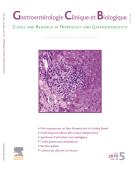Is there any relationship between pernicious anemia and iron deficiency? - 29/02/08
Stéphanie Lagarde [1],
Nicolas Jovenin [2],
Marie-Danièle Diebold [3],
Roland Jaussaud [4],
Virginie Cahn [3],
Eric Bertin [5],
Damien Jolly [2],
Gérard Thiéfin [1],
Guillaume Cadiot [1]
Mostrare le affiliazioniExiste-t-il une relation entre la maladie de Biermer et la carence martiale? |
Introduction |
Des études antérieures ont suggéré que la gastrite atrophique fundique pouvait être à l'origine d'une carence martiale. Le but de ce travail était d'évaluer la prévalence de la carence martiale dans la maladie de Biermer ainsi que les facteurs associés à cette anémie.
Matériels et méthodes |
Tous les malades atteints de maladie de Biermer diagnostiquée dans notre CHU entre janvier 1990 et février 2005 ont été inclus. Les critères d'inclusion étaient: 1- le diagnostic anatomo-pathologique de gastrite atrophique fundique et 2- un critère d'auto-immunité gastrique. Une relecture à l'aveugle des biopsies a été effectuée. La carence martiale était définie par une ferritinémie ≪ 15 µg/L chez les femmes et ≪ 40 µg/L chez les hommes.
Résultats |
Quatre-vingt-quinze malades (69 femmes), d'âge moyen 60 ans (extrêmes: 23-90), ont été inclus. L'hémogramme était normal chez 20 malades (21,1 %); une microcytose avec ou sans anémie était notée chez 12 malades (12,6 %) et une macrocytose avec ou sans anémie chez 53 (55,8 %). La ferritinémie a été dosée chez 58 malades, 16 (27,6 %) d'entre eux avaient une carence martiale, tous des femmes, significativement plus jeunes (39,2 ans) que les sujets sans carence martiale (61,6 ans, P ≪ 0,0001). Les taux moyens de gastrinémie n'étaient pas différents entre les 2 groupes avec et sans carence martiale. La sévérité de l'infiltrat inflammatoire fundique et la sévérité de l'hyperplasie des cellules endocrines fundiques étaient significativement plus importantes chez les malades avec carence martiale. En analyse multivariée, seuls le sexe féminin et l'âge ≪ 50 ans étaient associés à la carence martiale.
Conclusion |
La carence martiale et l'anémie microcytaire ne sont pas rares chez les malades ayant une maladie de Biermer et ne doivent pas faire méconnaître le diagnostic. La carence martiale ne semble pas liée au degré d'atrophie fundique mais au sexe féminin et au jeune âge, suggérant le rôle des pertes menstruelles. Le rôle éventuel de l'hypochlorhydrie en tant que facteur révélateur du déficit ferrique d'origine gynécologique n'a pas été démontré.
Introduction |
Previous studies have suggested that iron deficiency could be due to atrophic gastritis of the body/fundus. The aim of this study was to determine the prevalence of iron deficiency among patients with pernicious anemia and associated factors.
Patients and methods |
All patients with pernicious anemia diagnosed at our institution between January 1990 and February 2005 were included. Inclusion criteria were: 1- histological diagnosis of atrophic fundic gastritis and 2- criteria of gastric autoimmune involvement. Histology of gastric biopsies was performed in a blinded manner. Iron deficiency was defined as serum ferritin level ≪ 15 µg/L in women and ≪ 40 µg/L in men.
Results |
Ninety-five patients (69 women), mean age 60 years (range: 23-90) were included. Twenty patients (21.1 %) had normal blood cell counts; 12 patients (12.6 %) had microcytosis with or without anemia and 53 patients (55.8 %) macrocytosis with or without anemia. Serum ferritin levels were measured in 58 patients, 16 (27.6 %) of whom, all women, had iron deficiency. They were significantly younger (39.2 years) than patients without iron deficiency (61.6 years, P ≪ 0.0001). Serum gastrin levels did not differ between the groups with and without iron deficiency. A significantly more severe inflammatory infiltrate of the fundus and endocrine cell hyperplasia was observed in iron deficiency patients. Multivariate analysis showed that iron deficiency was linked to female gender and age ≪ 50 years.
Conclusion |
Iron deficiency and microcytic anemia are not rare in patients with pernicious anemia and should not rule out the diagnosis. Iron deficiency does not appear to be related to the degree of atrophic fundic gastritis but is linked to female gender and young age, suggesting menstrual blood loss could play a role. Whether decreased iron absorption due to reduced acid secretion favors the expression of gynecological iron loss cannot be ascertained.
Mappa
© 2006 Elsevier Masson SAS. Tous droits réservés.
Vol 30 - N° 11
P. 1245-1249 - Novembre 2006 Ritorno al numeroBenvenuto su EM|consulte, il riferimento dei professionisti della salute.

